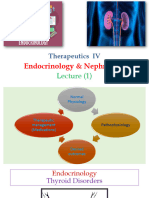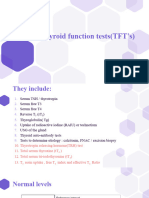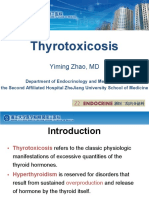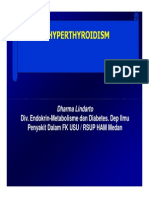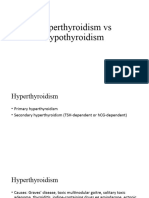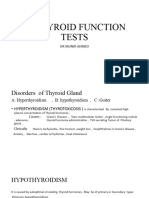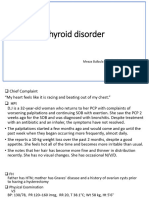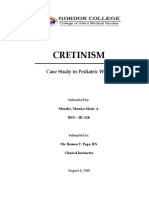Hypothyroidism
Hypothyroidism
Uploaded by
wael orabiCopyright:
Available Formats
Hypothyroidism
Hypothyroidism
Uploaded by
wael orabiCopyright
Available Formats
Share this document
Did you find this document useful?
Is this content inappropriate?
Copyright:
Available Formats
Hypothyroidism
Hypothyroidism
Uploaded by
wael orabiCopyright:
Available Formats
Canine Hypothyroidism
Hypothyroidism is common in older dogs but can be congenital (cretinism) in rare
cases. On a board exam, you should be able to recognize the signs of
hypothyroidism in dogs, choose appropriate diagnostic tests, and know about the
treatment. This PowerPage highlights those key aspects of this disease.
Key Points
● Key clinical signs include weight gain, lethargy, alopecia, pyoderma, and other skin changes.
● Diagnostic screening is typically performed with basal T4 levels but should often be confirmed with
additional endocrine tests.
● Treatment is with synthetic thyroid hormone (levothyroxine) orally.
Relevant Pathophysiology
Hypothyroidism most commonly occurs in dogs due to lymphocytic thyroiditis. The most common cause
of misdiagnosis is suppressed hypothalamic-pituitary stimulation of the thyroid due to illness (euthyroid
sick syndrome). The thyroid gland synthesizes the thyroid hormones thyroxine (T4) and triiodothyronine
(T3) which incorporate iodine. The hormones are responsible for a wide range of physiologic effects, but
most importantly they increase metabolic rate, oxygen consumption, heart rate, erythropoiesis, and
catecholamine response. They have catabolic effects on muscle and adipose tissue.
Clinical Signs
● Weight gain, obesity
● Lethargy
● Alopecia – often bilaterally symmetric over the lateral trunk, tail, and ventral thorax
● Pyoderma, hyperkeratosis, seborrhea, hyperpigmentation
● Bradycardia, weak pulses, low voltage ECG complexes
© 2018 VetPrep.com • All rights reserved. 1
Canine Hypothyroidism
Diagnosis
● Common abnormalities on routine blood work and diagnostics include:
a. Mild non-regenerative anemia
b. Hypercholesterolemia
● Serum total T4 level is the preferred screening test for hypothyroidism (normal ranges vary by lab)
● Dogs with normal T4 levels are not hypothyroid; dogs with low T4 levels may be hypothyroid but
this should be confirmed by at least one of the following:
a. Treat any identified underlying conditions
b. cTSH and free T4 by equilibrium dialysis levels
i. Hypothyroid dogs should have increased cTSH and low free T4
c. TSH stimulation test
i. Hypothyroid dogs should have low T4, even after TSH stimulation
d. Trial of T4 replacement therapy and assess response
Treatment
● Oral administration levothyroxine
a. Optimal dosing varies among dogs and T4 levels should be evaluated after beginning
therapy and while treatment is maintained. The dose should be calculated based on the
dog’s ideal body weight.
References
● Ettinger, Feldman- Veterinary Internal Medicine 3rd ed pp 1419-1429
© 2018 VetPrep.com • All rights reserved. 2
You might also like
- (FREE Ebook) How To Lose Weight Faster The Right WayDocument34 pages(FREE Ebook) How To Lose Weight Faster The Right WayMeleckzedeck MetiliNo ratings yet
- Endocrine McQs 430Document41 pagesEndocrine McQs 430MalikQamarAbbasThaheem86% (7)
- Reference Ranges PDFDocument94 pagesReference Ranges PDFdumitrescu sNo ratings yet
- Sophie Keyte Bvms (Hons) Mvetmed (Dist) Fhea Dipacvim Mrcvs Sophie - Keyte@Bristol - Ac.UkDocument24 pagesSophie Keyte Bvms (Hons) Mvetmed (Dist) Fhea Dipacvim Mrcvs Sophie - Keyte@Bristol - Ac.UkStefana UrsuNo ratings yet
- 1 s2.0 S0195561622001085 MainDocument18 pages1 s2.0 S0195561622001085 Mainkarinaramos.alunoNo ratings yet
- EndocrineDiseases1Document39 pagesEndocrineDiseases1Susan JesusNo ratings yet
- Neurologic Manifestations of Hypothyroidism in DogsDocument7 pagesNeurologic Manifestations of Hypothyroidism in DogsMahdawwNo ratings yet
- #30 Thyroid and Thyroid TestingDocument25 pages#30 Thyroid and Thyroid TestingasclswisconsinNo ratings yet
- Dark Modern Dogs Rescue Shelter Photo Collage Facebook PostDocument21 pagesDark Modern Dogs Rescue Shelter Photo Collage Facebook Postmathieulaid1No ratings yet
- Thiroid DisordersDocument11 pagesThiroid Disordersرعد النميريNo ratings yet
- Interpretation of Laboratory Thyroid Function Tests: The "Hidden" Health ProblemDocument38 pagesInterpretation of Laboratory Thyroid Function Tests: The "Hidden" Health Problemalanoud.877No ratings yet
- Abstract Hypothyroidism Canine ReviewDocument1 pageAbstract Hypothyroidism Canine ReviewMoin KhurshidNo ratings yet
- Chapter 37: Drugs Used To Treat Thyroid DiseaseDocument40 pagesChapter 37: Drugs Used To Treat Thyroid DiseaseAziil LiizaNo ratings yet
- Therapeutics: Thyroid DisordersDocument24 pagesTherapeutics: Thyroid DisordersSharas FarhadNo ratings yet
- HyperthyroidismDocument33 pagesHyperthyroidismNavin AdhikariNo ratings yet
- Lecture (1) - THDocument34 pagesLecture (1) - THyoussef hossamNo ratings yet
- Thyroid Function Tests (TFT'S) : Roll No 04Document22 pagesThyroid Function Tests (TFT'S) : Roll No 04Ajay YANo ratings yet
- ThyrotoxicosisDocument105 pagesThyrotoxicosisAli Murtaza Abbas100% (1)
- ThyroidDocument53 pagesThyroidabdallah.alhunity44No ratings yet
- Thyroid Function Test and Adrenal Function TestsDocument64 pagesThyroid Function Test and Adrenal Function TestsDr Abhinav Manish MDNo ratings yet
- SummariesDocument3 pagesSummarieslaithmasannatNo ratings yet
- Pharmacotherapy of Thyroid DisordersDocument6 pagesPharmacotherapy of Thyroid DisordersShaden -No ratings yet
- Kuliah Hyper and Hypothyroid - 2014Document66 pagesKuliah Hyper and Hypothyroid - 2014Clararida RiawanNo ratings yet
- Hypo Thyroid Is MDocument27 pagesHypo Thyroid Is Mdhiraj parmarNo ratings yet
- Mbs127 Slide Hyperthyroidism 1Document46 pagesMbs127 Slide Hyperthyroidism 1revita262No ratings yet
- Abhishek Sori_20250124_091533_0000Document37 pagesAbhishek Sori_20250124_091533_0000sr544540No ratings yet
- Hyperthyroidism Vs HypothyroidismDocument12 pagesHyperthyroidism Vs Hypothyroidismazizan hannyNo ratings yet
- 2.tyroid Gland DrsDocument55 pages2.tyroid Gland DrsAddis KusseNo ratings yet
- PSM 1 Peterson PDFDocument6 pagesPSM 1 Peterson PDFMaria Rodriguez RodrguezNo ratings yet
- HyperthyroidismDocument52 pagesHyperthyroidismHassan kamalNo ratings yet
- 02.Thyroid & Antithyroid Drugs - CopyDocument33 pages02.Thyroid & Antithyroid Drugs - Copyangatalawrence16No ratings yet
- 888-8004 Rev. B Rotor Utilization Guide-T4Document1 page888-8004 Rev. B Rotor Utilization Guide-T4Moisés RodríguezNo ratings yet
- Thyroid LectureDocument65 pagesThyroid LectureAndres TabaresNo ratings yet
- Thyroid Functions TestDocument11 pagesThyroid Functions TestFatima AsgharNo ratings yet
- Thyroid ReportDocument105 pagesThyroid ReportAARVNo ratings yet
- Thyroid DiseasesDocument44 pagesThyroid DiseasesPLDT HOMENo ratings yet
- Thyroid Disorders in The Geriatric Patient: Susan A. Meeking, DVMDocument19 pagesThyroid Disorders in The Geriatric Patient: Susan A. Meeking, DVMMaria Alice BourneufNo ratings yet
- Assessment and Management of Patients With Endocrine DisordersDocument11 pagesAssessment and Management of Patients With Endocrine DisordersLesley GonzalezNo ratings yet
- Endocrine SystemDocument59 pagesEndocrine Systemayesharajput5110No ratings yet
- Hypothyroidism 2Document50 pagesHypothyroidism 2Ziaur rabbi sakilNo ratings yet
- Laboratory Diagnostics of (Selected) Endocrine DisordersDocument48 pagesLaboratory Diagnostics of (Selected) Endocrine DisordersPaulina PaskeviciuteNo ratings yet
- Thyroid Function TestDocument21 pagesThyroid Function TestPat JacintoNo ratings yet
- Lecture 17 - Thyroid Disorders (Including Struma and CA Thyroid) - Dr. M. Robikhul Ikhsan, SP - PD-KEMD (2021)Document21 pagesLecture 17 - Thyroid Disorders (Including Struma and CA Thyroid) - Dr. M. Robikhul Ikhsan, SP - PD-KEMD (2021)Ivan AditamaNo ratings yet
- Thyroid Disorder: Meaza Bulbula (M. Pharm)Document61 pagesThyroid Disorder: Meaza Bulbula (M. Pharm)Ko MhdNo ratings yet
- Thyroid Function Tests: Drneha Mahajan MD PathologyDocument71 pagesThyroid Function Tests: Drneha Mahajan MD PathologyMukesh Kumar ChaudharyNo ratings yet
- THYROID Disorders For PB BSCDocument81 pagesTHYROID Disorders For PB BSCchetankumarbhumireddy67% (3)
- Lecture (2) TherapDocument25 pagesLecture (2) Therapyoussef hossamNo ratings yet
- Clinical Approach of Thyroid Disorders: Hypothyroidsm and HyperthyroidsmDocument73 pagesClinical Approach of Thyroid Disorders: Hypothyroidsm and HyperthyroidsmdiniNo ratings yet
- Hyperthyroidism NotesDocument17 pagesHyperthyroidism NotesAthira BabuNo ratings yet
- 11 Endocrinoly Lab Testss 2Document55 pages11 Endocrinoly Lab Testss 2kingland6No ratings yet
- Endocrine DisordersDocument52 pagesEndocrine DisordersMini lekhaNo ratings yet
- Thyroid DiseaseDocument30 pagesThyroid Diseasemy Lord JesusNo ratings yet
- Lec#15+16 Thyroid DisordersDocument82 pagesLec#15+16 Thyroid DisordersKhaldoun AlmomaniNo ratings yet
- HypothyroidismDocument14 pagesHypothyroidismmirmurtazarind82No ratings yet
- Hormones 20Document80 pagesHormones 20Stephanie Ortiz FonsecaNo ratings yet
- Disorders of The Thyroid1Document22 pagesDisorders of The Thyroid1Saddamix AL OmariNo ratings yet
- Thyroid DiseaseDocument36 pagesThyroid Diseasejozemomo206No ratings yet
- HypothyroidismDocument19 pagesHypothyroidismalirefaat717No ratings yet
- Hyper and HypothyroidismDocument63 pagesHyper and Hypothyroidismmeetgagiya2005No ratings yet
- Hyperthyroidism: Chap 10. Unit VIIDocument32 pagesHyperthyroidism: Chap 10. Unit VIIAizaz AhmadNo ratings yet
- Hyperthyroidism: A Practical Approach To Diagnosis and ManagementDocument70 pagesHyperthyroidism: A Practical Approach To Diagnosis and ManagementMutiara Manuella TambaNo ratings yet
- Thyroid Function TestDocument34 pagesThyroid Function TestAishaNo ratings yet
- Hypothyroidism, A Simple Guide To The Condition, Treatment And Related ConditionsFrom EverandHypothyroidism, A Simple Guide To The Condition, Treatment And Related ConditionsNo ratings yet
- Inserto T3Document2 pagesInserto T3cesiahdez33% (3)
- MineralsDocument70 pagesMineralsVioletteNo ratings yet
- Anph111 FinalsDocument50 pagesAnph111 FinalsxeanNo ratings yet
- Abcde DietDocument18 pagesAbcde Dietcraig1014No ratings yet
- Corrected 1041 File Part 1Document160 pagesCorrected 1041 File Part 1walebayo06No ratings yet
- IBO 2018 - Theoretical Exam ADocument51 pagesIBO 2018 - Theoretical Exam ALelouch vi Britannia The 3rd100% (2)
- Hypertiroidism MedicationsDocument6 pagesHypertiroidism MedicationsSalsabila HMNo ratings yet
- TSH Rapid Quantitative Test COA-F22017702ADDocument1 pageTSH Rapid Quantitative Test COA-F22017702ADg64bt8rqdwNo ratings yet
- Endocrine System Anatomy and PhysiologyDocument17 pagesEndocrine System Anatomy and PhysiologyKBD0% (1)
- Answers - Topical Test Chapter 7 Form 4Document1 pageAnswers - Topical Test Chapter 7 Form 4Etty SaadNo ratings yet
- EXAM PharmDocument40 pagesEXAM PharmJack PopNo ratings yet
- Lab ValuesDocument5 pagesLab ValuesJessNo ratings yet
- Neonatal Screening For Congenital Hypothyroidism - Toni TorresaniDocument6 pagesNeonatal Screening For Congenital Hypothyroidism - Toni TorresaniDIMAMIANo ratings yet
- Home Remedies For HypothyroidismDocument2 pagesHome Remedies For HypothyroidismRatnaPrasadNalamNo ratings yet
- Chemical Coordination and Integration by - Dr. Sunita SaxenaDocument66 pagesChemical Coordination and Integration by - Dr. Sunita SaxenaDivya AgarawalNo ratings yet
- Nihms 1679935Document33 pagesNihms 1679935Rebeca Tapia RsNo ratings yet
- Pathophysiology SimplifiedDocument321 pagesPathophysiology SimplifiedShaik zubairNo ratings yet
- VPHY 143 Parathyroid To ThyroidDocument3 pagesVPHY 143 Parathyroid To ThyroidRegulus Fidelis SevillaNo ratings yet
- A Brief Review in Dental Management of Medically Compromised PatientsDocument7 pagesA Brief Review in Dental Management of Medically Compromised PatientsMishellKarelisMorochoSegarraNo ratings yet
- Oral Aspects of Metabolic DiseasesDocument39 pagesOral Aspects of Metabolic DiseasesriyaNo ratings yet
- Kevin Murphy PHD ThesisDocument5 pagesKevin Murphy PHD Thesisnadinebenavidezfortworth100% (2)
- Thyroid Thyroid GlandDocument3 pagesThyroid Thyroid Glandjohnjoseph.ermitanoNo ratings yet
- Radioactive Iodine 131Document4 pagesRadioactive Iodine 131Kamila Furqani DjibranNo ratings yet
- Graves DiseaseDocument6 pagesGraves Diseaseabida.syeda.718No ratings yet
- Chapter 55 To 57-2 - Endocrine SurgeryDocument64 pagesChapter 55 To 57-2 - Endocrine Surgerydr.jitu2525No ratings yet
- Medical Device Grouping GuidanceDocument44 pagesMedical Device Grouping GuidanceAlaa Al masriNo ratings yet
- Cretenism Case StudyDocument8 pagesCretenism Case StudyMonica Marie MoralesNo ratings yet















